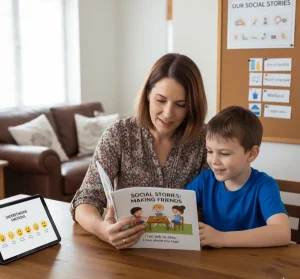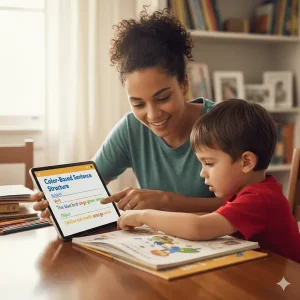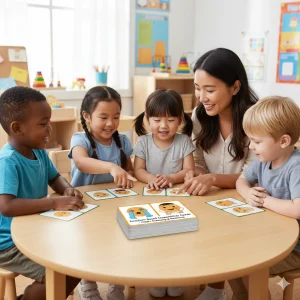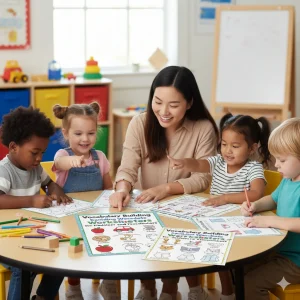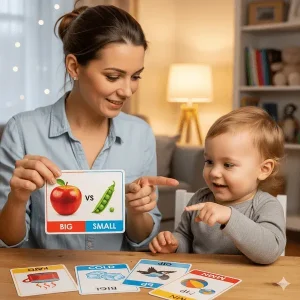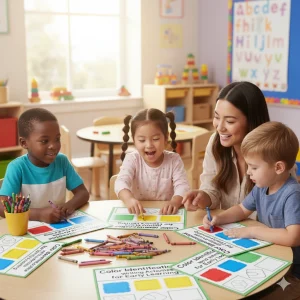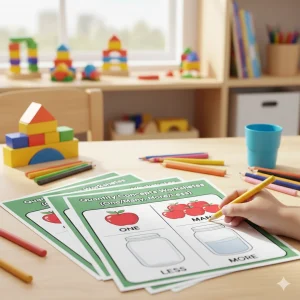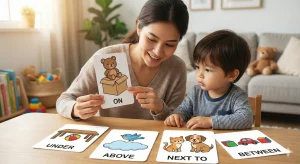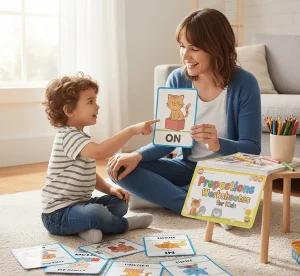How Bilingualism Affects Speech Development in Kids
By Rajini D
Last Updated: December 19, 2024
As bilingualism flourishes across the globe, understanding its impact on children’s speech development, particularly bilingual articulation, is crucial. Nearly one in four U.S. students speaks a language other than English at home, showcasing the rise of multilingual households. Contrary to common myths, exposing children to multiple languages from an early age does not hinder their speech development. In fact, it enriches cognitive abilities and cultural understanding. Stay tuned as we explore effective strategies for nurturing bilingual articulation, ensuring your child benefits from their rich linguistic environment.
Understanding Articulation in Bilingual Children
Articulation, or the way we form speech sounds, is a fundamental aspect of language development. For bilingual children, who are learning to navigate two linguistic landscapes, the journey of bilingual articulation can seem complex but is fascinatingly adaptive. These children not only learn to pronounce words from one language but toggle between two sets of linguistic rules, enhancing their phonetic repertoire from a young age. This process of bilingual articulation not only involves acquiring sounds from each language but also learning when and how to switch between them seamlessly.
Statistical Insight: In the United States, nearly 25% of public school students speak a language other than English at home, and in states like Texas, this figure rises to almost 33%. Such statistics highlight the increasing need for tailored speech and language support in educational and home settings.
Articulation Development in Bilingual Kids: Bilingual children typically develop articulation skills just as their monolingual peers do, but with a few interesting twists:
- First Words: Bilingual toddlers often reach speech milestones such as first words and simple phrases around the same age as monolingual children—usually by the age of two.
- Code-Switching: They may mix elements from both languages, a sign of linguistic flexibility, not confusion.
- Phonetic Diversity: Exposure to diverse sounds can lead to a more nuanced auditory discrimination, potentially aiding in more precise articulation skills over time.
Common Misconceptions About Bilingualism and Articulation
When it comes to raising bilingual children, parents often encounter a mix of advice that can be confusing and sometimes misleading. Let’s debunk some of the most common myths about bilingualism and bilingual articulation and set the facts straight with scientific insights. This focus on bilingual articulation aims to clarify how children manage and develop proficiency in producing speech sounds in two languages, reinforcing their ability to switch between linguistic systems seamlessly.
Also read: Bilingual Myths and Facts: Understanding Language Development
Myth 1: Bilingualism Causes Speech Delays
When it comes to raising bilingual children, parents often encounter a mix of advice that can be confusing and sometimes misleading. Let’s debunk some of the most common myths about bilingualism and bilingual articulation and set the facts straight with scientific insights. This focus on bilingual articulation aims to clarify how children manage and develop proficiency in producing speech sounds in two languages, reinforcing their ability to switch between linguistic systems seamlessly.
Fact Check: According to Kohnert (2008), bilingualism itself is not the cause of articulation or language disorders. Children who are bilingual develop speech and language skills just as monolingual children do, albeit sometimes at a slightly different pace in each language.
Myth 2: Bilingual Children Are More Likely to Need Speech Therapy
There’s a misconception that bilingual children are more likely to require speech therapy than their monolingual counterparts. In reality, bilingual children only show signs of true language disorders if there are consistent issues in both languages. A problem in only one language is more likely about language acquisition rather than a disorder.
Fact Check: Studies indicate that bilingual children may demonstrate a natural balance in language skills, with equal potential for proficiency in both languages over time, provided they receive adequate exposure and support for each language.
Myth 3: Reducing Exposure to One Language Will Improve the Other
Some believe that if a bilingual child struggles with articulation or language, reducing exposure to one language will benefit the other. This is not supported by evidence. In fact, reducing a child’s exposure to one of their languages can lead to loss of that language without improving the other.
Fact Check: Comprehensive linguistic exposure is crucial. Reducing interaction in one language does not necessarily improve the other; instead, it can lead to a decrease in overall linguistic competence (Kohnert, 2008).
Wellness Hub Insight:
At Wellness Hub, we encourage parents to nurture both languages in a bilingual home. Balanced exposure helps children maximize their cognitive and linguistic potential, embracing their bilingual heritage without compromise.
Milestones in Bilingual Articulation Development
Understanding the developmental milestones of speech and language for bilingual children helps parents and educators ensure that children are on the right track. The path to articulation for bilingual kids may slightly differ from their monolingual peers, but essentially, they should meet similar developmental markers, just with a richer linguistic environment.
Normal Speech and Language Milestones for Bilingual Children
Bilingual children blend the linguistic features of both languages they are learning. This dual-language learning can sometimes make it seem like they are slower in language acquisition, but they are actually just learning more content. Key milestones include:
- First Words: Typically appear around the first birthday, just as in monolingual children.
- Two-Word Phrases: Expected by age two, similar to their monolingual peers.
- Language Differentiation: Most bilingual children can differentiate between their two languages by the age of three, often using both languages in one sentence or switching mid-conversation based on their listener.
Comparison of Milestones for Bilingual vs. Monolingual Children
| Age | Bilingual Children | Monolingual Children | Notes |
|---|---|---|---|
| 12 months | 2-6 words from either/both languages | 2-6 words in one language | Bilinguals might mix languages in phrases |
| 24 months | Combining words from both languages | Combining words in one language | Similar developmental pace, with linguistic mixing in bilinguals |
| 36 months | Differentiating languages, using complex sentences | Using complex sentences in one language | Bilinguals start clearly differentiating languages |
Signs of Articulation Issues in Bilingual Kids
Identifying whether a bilingual child has a speech and language disorder or simply a difference due to learning two languages can be challenging. Here are some red flags that may indicate a disorder rather than a difference:
- Consistent Difficulty Across Both Languages: While it’s normal for bilingual children to lag slightly in one language, persistent difficulties in both languages might indicate a disorder.
- Limited Vocabulary in Both Languages: If a child’s vocabulary growth is stunted in both languages compared to peers, it may be a sign of a language disorder.
- Problems with Understanding in Both Languages: Difficulty following simple commands or responding to questions appropriately in both languages can be concerning.
Language Differences vs. Disorders:
- Language Difference: Temporary and isolated challenges in one language, often due to less exposure.
- Language Disorder: Persistent and pervasive challenges in both languages, often unrelated to exposure levels.
Strategies for Supporting Bilingual Articulation at Home
Raising a bilingual child is an incredibly rewarding journey that comes with its unique set of challenges and triumphs. As parents, your involvement is pivotal in nurturing your child’s ability to articulate in both languages effectively. Here are some practical strategies to support bilingual articulation at home:
Consistent Language Exposure
The key to successful bilingual language development is consistent exposure to both languages. It’s important to create a rich linguistic environment where both languages are valued equally. Consider these tips:
- Designated Language Times: Allocate specific times or days for each language. For example, one parent could speak one language with the child, while the other parent uses the second language.
- Diverse Language Resources: Incorporate books, music, movies, and games in both languages to make learning fun and engaging.
- Interaction with Native Speakers: If possible, arrange playdates or social interactions with native speakers of both languages. This real-life practice is invaluable.
Parental Involvement
Active participation in your child’s language acquisition process can significantly enhance their articulation skills.
- Read Aloud: Regularly read stories in both languages. This not only helps with pronunciation but also with listening skills.
- Narrate and Describe: Talk through everyday activities and routines in both languages to build vocabulary and contextual understanding.
- Encourage Expression: Engage your child in conversations that encourage them to express their thoughts in both languages, correcting gently without discouraging them.
When to Seek Professional Help
While many children thrive in a bilingual environment without professional intervention, there are times when consulting with a bilingual speech-language pathologist might be necessary.
Signs to Consult a Professional
- Stagnation or Regression: If there’s no progression in language skills or if your child begins to regress, it may be time to seek help.
- Frustration or Withdrawal: Should your child show signs of frustration during communication or start withdrawing from verbal interaction, it could indicate underlying issues.
- School Recommendations: Sometimes, observations from educators may prompt a need for professional evaluation.
What to Expect from an Assessment
A comprehensive assessment by a bilingual speech-language pathologist will involve:
- Initial Consultation: Discussing the child’s linguistic background, family history, and any concerns.
- Formal and Informal Assessments: Using standardized tests and observational techniques to evaluate language understanding, usage, and articulation in both languages.
- Detailed Feedback and Plan: Providing a diagnosis if any, along with tailored strategies for intervention and support at home and in educational settings.
The Benefits of Bilingualism
Embracing bilingualism from an early age opens up a world of opportunities that extends beyond the ability to communicate in two languages. The cognitive and social advantages of being bilingual are profound and well-documented, offering long-term benefits that can shape educational pathways and career opportunities.
Cognitive Advantages of Bilingualism
Research by Marian & Spivey (2003) highlights how bilingual individuals excel in areas of executive function such as problem-solving, multitasking, and focusing attention. These skills are enhanced because bilingual brains are accustomed to switching between languages, effectively giving the brain a daily workout. Additionally, a study by Mohades et al. (2012) suggests that bilingual children tend to have better-developed working memories than their monolingual counterparts, aiding in various aspects of academic performance.
Key Cognitive Benefits:
- Enhanced Executive Functions: Regular practice in switching languages improves mental flexibility and control.
- Improved Memory: Handling two languages enhances working memory, aiding in learning and retention.
- Better Problem-Solving Skills: Bilinguals tend to have superior problem-solving abilities due to the need to navigate and negotiate meaning in two different linguistic frameworks.
Social Benefits of Being Bilingual
Socially, bilingual individuals often find it easier to connect with a broader range of people. This cultural agility enables them to navigate different social landscapes more effectively, which is increasingly valuable in our globalized world.
Key Social Benefits:
- Increased Cultural Sensitivity: Exposure to multiple cultures fosters greater empathy and understanding.
- Enhanced Communication Skills: Bilinguals often develop more nuanced communication skills, understanding not just languages but also non-verbal cues across cultures.
Long-Term Advantages of Bilingual Education
Investing in bilingual education can yield significant long-term benefits:
- Academic Success: Studies have shown that bilingual students often outperform their monolingual peers in academic tests, particularly in reading comprehension and vocabulary tests.
- Career Opportunities: Proficiency in multiple languages is highly prized in many professional fields, including diplomacy, business, and healthcare.
- Resilience Against Cognitive Decline: Research suggests that being bilingual can help delay the onset of dementia and other forms of cognitive decline in older age.
Conclusion
Raising bilingual children is a rewarding journey that enriches their lives with vast cultural and cognitive benefits. As parents, your active involvement in nurturing their language skills paves the way for a future where they can effortlessly bridge diverse worlds. At Wellness Hub, we’re here to support you with tools and insights that make this journey smoother. Embrace bilingualism and watch your child thrive in a connected, multilingual world.
Frequently Asked Questions:
1. What age should a child start learning a second language?
Children benefit from being exposed to a second language as early as infancy. The earlier they start, the more naturally they acquire language skills. Early exposure helps in achieving fluency and accent mastery, akin to that of a native speaker.
2. Does raising a child bilingually cause speech delays?
While bilingual children may start speaking a bit later than monolingual peers, this is typically within the normal range of language development milestones. The slight delay is because they are learning to navigate two linguistic systems. Research indicates that bilingualism does not cause long-term speech or language problems.
3. How can parents support bilingual language development at home?
Consistency is key in supporting bilingual language development. Speak regularly in both languages, provide a variety of linguistic inputs like books, music, and interactive games in both languages, and encourage family or friends who are fluent to also speak the second language around the child.
4. What are the signs of language disorders in bilingual children?
Look for consistent difficulty in understanding or forming sentences in both languages, limited vocabulary that doesn’t improve with age, and frequent frustration or withdrawal during communication. These could indicate a language disorder, unlike simpler language mixing which is a normal part of bilingual development.
5. Are there cognitive benefits to being bilingual?
Yes, numerous studies suggest that bilingual individuals often have better attention and task-switching capacities than monolinguals. This cognitive advantage, known as the “bilingual executive function advantage,” can contribute to better academic performance and problem-solving skills.
6. Can learning two languages confuse my child?
Learning two languages does not confuse children but instead enhances cognitive flexibility and awareness of different linguistic structures. Temporary mixing of languages is a normal part of bilingual development and usually resolves as children grow.
7. What should I do if my child mixes languages?
Language mixing or “code-switching” is a typical part of bilingual language development. Parents should continue to provide clear and consistent language input and understand that this phase is temporary and part of learning multiple languages.
8. How do bilingual children perform academically compared to monolingual children?
Research shows that bilingual children may initially lag slightly in vocabulary knowledge in each language compared to monolingual peers but typically catch up and may even excel, particularly in tasks involving creative thinking and problem-solving.
9. When should I seek help from a speech-language pathologist?
If concerns about language development persist, such as your child not meeting typical language milestones for either language, showing persistent difficulties in pronunciation, or struggling with understanding or forming sentences by the preschool years, it might be time to consult a speech-language pathologist.
10. What are the long-term benefits of being bilingual?
Long-term benefits of bilingualism include enhanced ability to focus and process information, greater ease in learning additional languages, more diverse career opportunities, and even potential protective effects against cognitive decline in later life, such as delaying the onset of dementia.
About the Author:
Rajini Darugupally
M.Sc., Speech-Language Pathologist (9+ years of experience)
Rajini is a passionate and dedicated Speech-Language Pathologist with over 9+ years of experience, specializing in both developmental speech and language disorders in children and rehabilitation in adults. Currently, at Wellness Hub, she thrives in a team environment that values innovation, compassion, and achieving results for their clients.
Book your Free Consultation Today
Parent/Caregiver Info:
Client’s Details:
* Error Message
